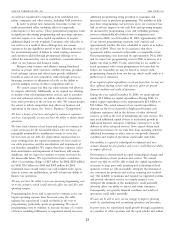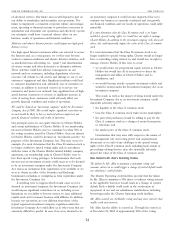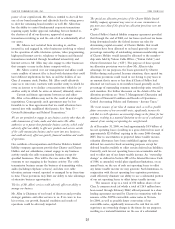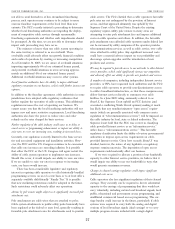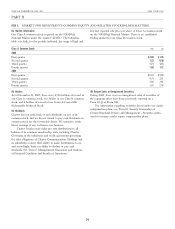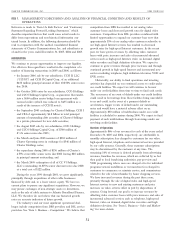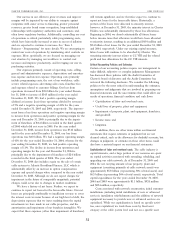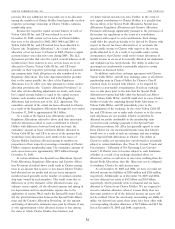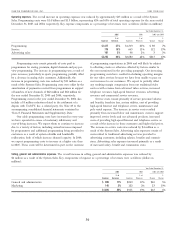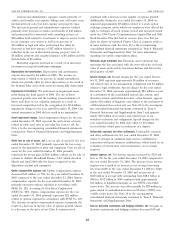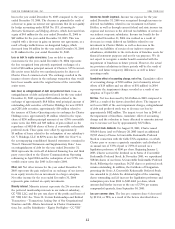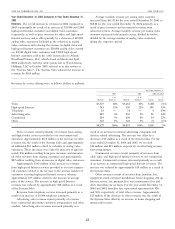Charter 2005 Annual Report Download - page 42
Download and view the complete annual report
Please find page 42 of the 2005 Charter annual report below. You can navigate through the pages in the report by either clicking on the pages listed below, or by using the keyword search tool below to find specific information within the annual report.
CHARTER COMMUNICATIONS, INC. 2005 FORM 10-K
Our success in our efforts to grow revenues and improve will remain significant, and we therefore expect to continue to
margins will be impacted by our ability to compete against report net losses for the foreseeable future. Historically, a
companies with easier access to financing, greater personnel portion of the losses were allocated to minority interest,
resources, greater brand name recognition, long-established however, at December 31, 2003, the minority interest in Charter
relationships with regulatory authorities and customers, and, Holdco was substantially eliminated by these loss allocations.
often fewer regulatory burdens. Additionally, controlling our cost Beginning in 2004, we absorb substantially all future losses
of operations is critical, particularly cable programming costs, before income taxes that otherwise would have been allocated
which have historically increased at rates in excess of inflation to minority interest, resulting in an additional $454 million and
and are expected to continue to increase. See ‘‘Item 1. $2.4 billion of net losses for the year ended December 31, 2005
Business — Programming’’ for more details. We are attempting to and 2004, respectively. Under our existing capital structure,
control our costs of operations by maintaining strict controls on future losses will continue to be absorbed by Charter. The
expenses. More specifically, we are focused on managing our remaining minority interest relates to CC VIII and the related
cost structure by managing our workforce to control cost profit and loss allocations for the CC VIII interests.
increases and improve productivity, and leveraging our size in Critical Accounting Policies and Estimates
purchasing activities. Certain of our accounting policies require our management to
Our expenses primarily consist of operating costs, selling, make difficult, subjective or complex judgments. Management
general and administrative expenses, depreciation and amortiza- has discussed these policies with the Audit Committee of
tion expense and interest expense. Operating costs primarily Charter’s board of directors and the Audit Committee has
include programming costs, the cost of our workforce, cable reviewed the following disclosure. We consider the following
service related expenses, advertising sales costs, franchise fees policies to be the most critical in understanding the estimates,
and expenses related to customer billings. Our loss from assumptions and judgments that are involved in preparing our
operations decreased from $2.0 billion for year ended Decem- financial statements and the uncertainties that could affect our
ber 31, 2004 to income of $343 million for the year ended results of operations, financial condition and cash flows:
December 31, 2005. We had a positive operating margin
(Capitalization of labor and overhead costs;
(defined as income (loss) from operations divided by revenues)
of 7% and a negative operating margin of 41% for the years (Useful lives of property, plant and equipment;
ended December 31, 2005 and 2004, respectively. The improve-
(Impairment of property, plant, and equipment, franchises,
ment from a loss from operations and negative operating margin and goodwill;
to income from operations and positive operating margin for the
year end December 31, 2005 is principally due to the impair- (Income taxes; and
ment of franchises of $2.4 billion recorded in the third quarter (Litigation.
of 2004 which did not recur in 2005. For the year ended
December 31, 2003, income from operations was $516 million In addition, there are other items within our financial
and for the year ended December 31, 2004, our loss from statements that require estimates or judgment but are not
operations was $2.0 billion. We had a negative operating margin deemed critical, such as the allowance for doubtful accounts, but
of 41% for the year ended December 31, 2004, whereas for the changes in judgment, or estimates in these other items could
year ending December 31, 2003, we had positive operating also have a material impact on our financial statements.
margin of 11%. The decline in income from operations and Capitalization of labor and overhead costs. The cable industry is
operating margin for the year end December 31, 2004 is capital intensive, and a large portion of our resources are spent
principally due to the impairment of franchises of $2.4 billion on capital activities associated with extending, rebuilding, and
recorded in the third quarter of 2004. The year ended upgrading our cable network. As of December 31, 2005 and
December 31, 2004 also includes a gain on the sale of certain 2004, the net carrying amount of our property, plant and
cable systems to Atlantic Broadband Finance, LLC which is equipment (consisting primarily of cable network assets) was
substantially offset by an increase in option compensation approximately $5.8 billion (representing 36% of total assets) and
expense and special charges when compared to the year ended $6.3 billion (representing 36% of total assets), respectively. Total
December 31, 2003. Although we do not expect charges for capital expenditures for the years ended December 31, 2005,
impairment in the future of comparable magnitude, potential 2004 and 2003 were approximately $1.1 billion, $924 million
charges could occur due to changes in market conditions. and $854 million, respectively.
We have a history of net losses. Further, we expect to Costs associated with network construction, initial customer
continue to report net losses for the foreseeable future. Our net installations (including initial installations of new or advanced
losses are principally attributable to insufficient revenue to cover services), installation refurbishments and the addition of network
the interest costs we incur because of our high level of debt, the equipment necessary to provide new or advanced services are
depreciation expenses that we incur resulting from the capital capitalized. While our capitalization is based on specific activi-
investments we have made in our cable properties, and the ties, once capitalized, we track these costs by fixed asset
amortization and impairment of our franchise intangibles. We category at the cable system level and not on a specific asset
expect that these expenses (other than impairment of franchises)
32



